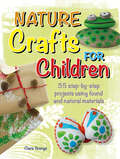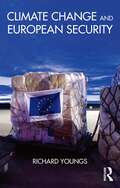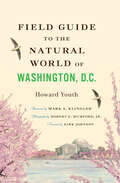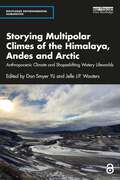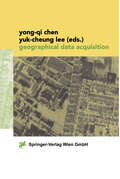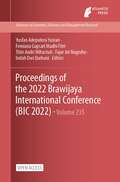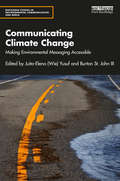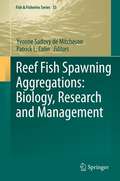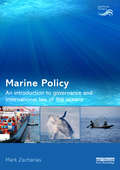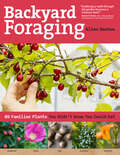- Table View
- List View
Nature Crafts for Children
by Clare YoungsKeep your kids’ boredom at bay with 35 environmentally-friendly ideas they’ll love to make. Designed with the environment in mind, this brilliant collection of craft projects will keep kids entertained for hours. It features decorations, toys, jewellery, gifts, and more, every one of them incorporating natural materials – woodland folk are created from pine cones and seed pods, a length of bark is the base for an animal painting, and a piece of slate is transformed into a pretty brooch or badge. The fun ideas range from bark rubbings for budding artists to herb head flowerpots for junior gardeners and are sure to give kids the creative bug. Best of all, finding the project materials encourages kids to get outside! They can gather shells on the beach to make the shell mice, or collect leaves and twigs on a countryside walk to make a printed fox wall hanging. Even their own garden will become an exciting source of crafty materials.
Climate Change and European Security (Routledge Advances in European Politics)
by Richard YoungsIt is now commonly asserted that climate change will fundamentally change international relations. It has been predicted that global warming will increase conflict within and between states, intensify food insecurity, menace the global trading system and unleash waves of migration. As a result governments are beginning to incorporate these warnings into their foreign policy initiatives. The appropriateness of their incipient responses needs to be examined in finer detail. This book looks at the impact of climate change on European Union (EU) security policy. It explores how governments are reconfiguring their geo-strategy and broader international relations in the wake of climate change warnings. The book demonstrates that although many aspects of EU foreign policies have begun to change, ‘climate security’ is not yet accorded unequivocal or sufficient priority. In doing so, Youngs argues that if climate change policies are to have significant effect they can no longer be treated as a separate area of policy but must be incorporated into the more mainstream debates pertinent to EU common foreign and security policy (CFSP). This book will be of key interest to students, scholars and practitioners of climate change and policy, energy and environmental policy, EU governance and foreign policy, European studies, international relations, geography, security studies/policy and environmental economics.
Climate Change and European Security (Routledge Advances in European Politics)
by Richard YoungsIt is now commonly asserted that climate change will fundamentally change international relations. It has been predicted that global warming will increase conflict within and between states, intensify food insecurity, menace the global trading system and unleash waves of migration. As a result governments are beginning to incorporate these warnings into their foreign policy initiatives. The appropriateness of their incipient responses needs to be examined in finer detail. This book looks at the impact of climate change on European Union (EU) security policy. It explores how governments are reconfiguring their geo-strategy and broader international relations in the wake of climate change warnings. The book demonstrates that although many aspects of EU foreign policies have begun to change, ‘climate security’ is not yet accorded unequivocal or sufficient priority. In doing so, Youngs argues that if climate change policies are to have significant effect they can no longer be treated as a separate area of policy but must be incorporated into the more mainstream debates pertinent to EU common foreign and security policy (CFSP). This book will be of key interest to students, scholars and practitioners of climate change and policy, energy and environmental policy, EU governance and foreign policy, European studies, international relations, geography, security studies/policy and environmental economics.
Field Guide to the Natural World of Washington, D.C.
by Howard YouthNature awaits discovery at almost every turn in the complex ecosystem of Washington, D.C. In parks large and small, within the District's gardens, and on public streets, there is tremendous biodiversity. In Field Guide to the Natural World of Washington, D.C., naturalist Howard Youth takes us on an urban safari, describing the wild side of the nation's capital.Beyond the abundant wildlife that can be seen in every neighborhood, Washington boasts a large park network rich in natural wonders. A hike along the trails of Rock Creek Park, one of the country’s largest and oldest urban forests, quickly reveals white-tailed deer, eastern gray squirrels, and little brown bats. Mayapples, Virginia bluebells, and red mulberry trees are but a few of the treasures found growing at the National Arboretum. A stroll along the Potomac and Anacostia Rivers might reveal stealthy denizens such as bullfrogs, largemouth bass, and common snapping turtles. Detailed drawings by Carnegie artist Mark A. Klingler and photography by Robert E. Mumford, Jr., reveal the rich color and stunning beauty of the flora and fauna awaiting every D.C. naturalist.Whether seeking a secluded jog or an adventurous outing, residents and tourists alike will find this handsome guide indispensable for finding oases away from the noise of the city.
Field Guide to the Natural World of Washington, D.C.
by Howard YouthNature awaits discovery at almost every turn in the complex ecosystem of Washington, D.C. In parks large and small, within the District's gardens, and on public streets, there is tremendous biodiversity. In Field Guide to the Natural World of Washington, D.C., naturalist Howard Youth takes us on an urban safari, describing the wild side of the nation's capital.Beyond the abundant wildlife that can be seen in every neighborhood, Washington boasts a large park network rich in natural wonders. A hike along the trails of Rock Creek Park, one of the country’s largest and oldest urban forests, quickly reveals white-tailed deer, eastern gray squirrels, and little brown bats. Mayapples, Virginia bluebells, and red mulberry trees are but a few of the treasures found growing at the National Arboretum. A stroll along the Potomac and Anacostia Rivers might reveal stealthy denizens such as bullfrogs, largemouth bass, and common snapping turtles. Detailed drawings by Carnegie artist Mark A. Klingler and photography by Robert E. Mumford, Jr., reveal the rich color and stunning beauty of the flora and fauna awaiting every D.C. naturalist.Whether seeking a secluded jog or an adventurous outing, residents and tourists alike will find this handsome guide indispensable for finding oases away from the noise of the city.
Field Guide to the Natural World of Washington, D.C.
by Howard YouthNature awaits discovery at almost every turn in the complex ecosystem of Washington, D.C. In parks large and small, within the District's gardens, and on public streets, there is tremendous biodiversity. In Field Guide to the Natural World of Washington, D.C., naturalist Howard Youth takes us on an urban safari, describing the wild side of the nation's capital.Beyond the abundant wildlife that can be seen in every neighborhood, Washington boasts a large park network rich in natural wonders. A hike along the trails of Rock Creek Park, one of the country’s largest and oldest urban forests, quickly reveals white-tailed deer, eastern gray squirrels, and little brown bats. Mayapples, Virginia bluebells, and red mulberry trees are but a few of the treasures found growing at the National Arboretum. A stroll along the Potomac and Anacostia Rivers might reveal stealthy denizens such as bullfrogs, largemouth bass, and common snapping turtles. Detailed drawings by Carnegie artist Mark A. Klingler and photography by Robert E. Mumford, Jr., reveal the rich color and stunning beauty of the flora and fauna awaiting every D.C. naturalist.Whether seeking a secluded jog or an adventurous outing, residents and tourists alike will find this handsome guide indispensable for finding oases away from the noise of the city.
Storying Multipolar Climes of the Himalaya, Andes and Arctic: Anthropocenic Climate and Shapeshifting Watery Lifeworlds (Routledge Environmental Humanities)
by Dan Smyer Yü Jelle J.P. WoutersThis book initiates multipolar climate/clime studies of the world’s altitudinal and latitudinal highlands with terrestrial, experiential, and affective approaches. Framed in the environmental humanities, it is an interdisciplinary, comparative study of the mutually-embodied relations of climate, nature, culture, and place in the Himalaya, Andes, and Arctic. Innovation-driven, the book offers multipolar clime case studies through the contributors’ historical findings, ethnographic documentations, and diverse conceptualizations and applications of clime, an overlooked but returning notion of place embodied with climate history, pattern, and changes. The multipolar clime case studies in the book are geared toward deeper, lively explorations and demonstrations of the translatability, interchangeability, and complementarity between the notions of clime and climate. "Multipolar" or "multipolarity" in this book connotes not only the two polar regions and the tectonically shaped highlands of the earth but also diversely debated perspectives of climate studies in the broadest sense. Contributors across the twelve chapters come from diverse fields of social and natural sciences and humanities, and geographically specialize, respectively, in the Himalayan, Andean, and Arctic regions. The first comparative study of climate change in altitudinal and latitudinal highlands, this will be an important read for students, academics, and researchers in environmental humanities, anthropology, climate science, indigenous studies, and ecology.
Environmental Humanities in the New Himalayas: Symbiotic Indigeneity, Commoning, Sustainability (Routledge Environmental Humanities)
by Dan Smyer Yü Erik De MaakerEnvironmental Humanities in the New Himalayas: Symbiotic Indigeneity, Commoning, Sustainability showcases how the eco-geological creativity of the earth is integrally woven into the landforms, cultures, and cosmovisions of modern Himalayan communities. Unique in scope, this book features case studies from Bhutan, Assam, Sikkim, Tibet, Nepal, Pakistan, and Sino-Indian borderlands, many of which are documented by authors from indigenous Himalayan communities. It explores three environmental characteristics of modern Himalayas: the anthropogenic, the indigenous, and the animist. Focusing on the sentient relations of human-, animal-, and spirit-worlds with the earth in different parts of the Himalayas, the authors present the complex meanings of indigeneity, commoning and sustainability in the Anthropocene. In doing so, they show the vital role that indigenous stories and perspectives play in building new regional and planetary environmental ethics for a sustainable future. Drawing on a wide range of expert contributions from the natural sciences, social sciences, and humanist disciplines, this book will be of great interest to students and scholars of environmental humanities, religion and ecology, indigenous knowledge and sustainable development more broadly.
Environmental Humanities in the New Himalayas: Symbiotic Indigeneity, Commoning, Sustainability (Routledge Environmental Humanities)
by Dan Smyer Yü Erik De MaakerEnvironmental Humanities in the New Himalayas: Symbiotic Indigeneity, Commoning, Sustainability showcases how the eco-geological creativity of the earth is integrally woven into the landforms, cultures, and cosmovisions of modern Himalayan communities. Unique in scope, this book features case studies from Bhutan, Assam, Sikkim, Tibet, Nepal, Pakistan, and Sino-Indian borderlands, many of which are documented by authors from indigenous Himalayan communities. It explores three environmental characteristics of modern Himalayas: the anthropogenic, the indigenous, and the animist. Focusing on the sentient relations of human-, animal-, and spirit-worlds with the earth in different parts of the Himalayas, the authors present the complex meanings of indigeneity, commoning and sustainability in the Anthropocene. In doing so, they show the vital role that indigenous stories and perspectives play in building new regional and planetary environmental ethics for a sustainable future. Drawing on a wide range of expert contributions from the natural sciences, social sciences, and humanist disciplines, this book will be of great interest to students and scholars of environmental humanities, religion and ecology, indigenous knowledge and sustainable development more broadly.
Development and Evaluation of High Resolution Climate System Models
by Rucong Yu Tianjun Zhou Tongwen Wu Wei Xue Guangqing ZhouThis book is based on the project “Development and Validation of High Resolution Climate System Models” with the support of the National Key Basic Research Project under grant No. 2010CB951900. It demonstrates the major advances in the development of new, dynamical Atmospheric General Circulation Model (AGCM) and Ocean General Circulation Model (OGCM) cores that are suitable for high resolution modeling, the improvement of model physics, and the design of a flexible, multi-model ensemble coupling framework. It is a useful reference for graduate students, researchers and professionals working in the related areas of climate modeling and climate change. Prof. Rucong Yu works at the China Meteorological Administration; Prof. Tianjun Zhou works at LASG, the Institute of Atmospheric Physics, Chinese Academy of Sciences; Tongwen Wu works at Beijing Climate Center, China Meteorological Administration; Associate Prof. Wei Xue works at the Department of Computer Science and Technology, Tsinghua University; Prof. Guangqing Zhou works at the Institute of Atmospheric Physics (IAP), Chinese Academy of Sciences.
Material Cycling of Wetland Soils Driven by Freeze-Thaw Effects (Springer Theses)
by Xiaofei YuFreezing and thawing of soils is a common phenomenon in the winter-cold zone. The thesis titled “Material Cycling of Wetland Soils Driven by Freeze-Thaw Effects” systematically explores the freeze-thaw effects on the accumulation and release processes of carbon and nitrogen in wetland soils, which is a good step toward the investigation of biogeochemical processes in wetlands in seasonal freeze-thaw areas. It is also developing strategies aimed at global warming effects on the accumulation and release of carbon and nitrogen in wetlands. Dr. Xiaofei Yu works at the Northeast Institute of Geography and Agroecology, Chinese Academy of Sciences, China.
Geographical Data Acquisition
by Yuk-CheungLee Yong-QiChenThis book presents the theory and methodology of geographical data acquisition, providing comprehensive coverage ranging from the definition of geo-referencing systems and transformation between these systems to the acquisition of geographical data using different methods. The material provides readers with a good understanding of the nature of spatial data, the accuracy of spatial data, and the theory behind various data acquisition methodologies.
Environmental Stress: Indication, Mitigation and Eco-conservation
by Mohammad Yunus Nandita Singh L. J. De KokIn the present scenario, stresses induced due to global environmental change have indeed become a focal point of researches and study programmes worldwide. Stress caused to plant life has an important consequence to both, vegetation as such and all other global cycles which sustain this `living earth'. Unlike other already existing works this volume elucidates the plant-pollutant relationship in a manner that defines not only the drastic effects of pollutants on plants but concomitantly highlights the hitherto less focused areas namely phytoindication, phytoremediation and stress tolerant bioaesthetic development, thus concentrating more on plant than pollutant. The book would help understand the magnitude of environmental stress in the coming years and may play a formative role in defining future research and policy areas along with providing impetus to development of newer eco-technologies. The book shall interest both students and researchers of environmental sciences, ecology, forestry and related disciplines as well as persons and organisations engaged in environmental management and eco-conservation.
Proceedings of the 2022 Brawijaya International Conference (Advances in Economics, Business and Management Research #235)
by Yusfan Adeputera Yusran Femiana Gapsari Madhi Fitri Titin Andri Wihastuti Fajar Ari Nugroho Indah Dwi QurbaniThis is an open access book.We proudly present the 2022 Brawijaya International Conference (BIC) as the consecutive series of conferences that is organised and hosted annually by Univeritas Brawijaya, Indonesia. The BIC 2022 will be held in Bali, Indonesia, on October 7 – 9, 2022. The conference committee consists of multi department of Univeritas Brawijaya. The BIC 2022 will present multidisciplinary research, community service essay and research, and industrial findings related to sustainable development. The BIC 2022 will be a great opportunity for exchanging ideas and knowledge in all multidisciplinary areas for academicians, scientists, practitioners, and global executives. The event will facilitate a focus group discussion and consultation for the participants, especially stakeholders, to address the current issues and challenges including the future invention and innovation within multidisciplinary areas.The BIC 2022 invites fellow researchers/scientists, students, practitioners, global executives from multidisciplinary areas to participate and gather in this event to share and discuss the related research result and finding from all multidisciplinary areas. You should not miss the great opportunity to establish partnership and acquire tremendous knowledge within the BIC 2022.
Communicating Climate Change: Making Environmental Messaging Accessible (Routledge Studies in Environmental Communication and Media)
by Juita-Elena Wie Yusuf Burton St. John IIIThis edited collection focuses on theoretical and applied research-based observations concerning how experts, advocates, and institutions make climate change information accessible to different audiences. Communicating Climate Change concentrates on three key elements of climate change communication – access, relevance, and understandability – to provide an overview of how these aspects allow multiple groups of stakeholders to act on climate-related information to build resilience. Featuring contributions from a wide range of scholars from across different disciplines, this book explores a multitude of different scenarios and communication methods, including social media; public opinion surveys; participatory mapping; and video. Overall, climate change communication is addressed from three different perspectives: communicating with the public; communicating for stakeholder engagement; and organizational, institutional, risk, and disaster communication. With each chapter focusing on implications and applications for practice, this book will be of great interest to students and researchers of climate change and environmental communication, as well as practitioners interested in understanding how to better engage stakeholders through climate change-related communication.
Reef Fish Spawning Aggregations: Biology, Research and Management (Fish & Fisheries Series #35)
by Yvonne Sadovy Sadovy de Mitcheson and Patrick L. L. ColinReef fish spawning aggregations, ranging from small groups to many tens of thousands of individuals, are spectacular but poorly known natural phenomena whereby fish assemble at specific times and locations to spawn. For some species these large groups may be the only form of reproduction, the high fish numbers briefly giving a false impression of stability and abundance—an ‘illusion of plenty’. They are often a focus for intensive seasonal fishing because of their predictability and because many important commercial fishes form them. Highly vulnerable to overexploitation, many aggregations and their associated fisheries, have disappeared or are in decline. Few are effectively managed or incorporated into protected areas. Aggregations are not well understood by fishery scientists, managers and conservationists and their significance little appreciated by fishers or the wider public. To ensure their persistence to replenish important fisheries in coral ecosystems, maintain their ecosystem function and continue to delight divers, a significant change in perspective is needed to foster protection and management. This book provides comprehensive and practical coverage of the biology, study and management of reef fish aggregations, exploring their how, when, where, and why. It explores ways to better protect, study, manage and conserve them, while identifying key data gaps and questions. The text is extensively illustrated with many unique, never before published, photographs and graphics. Case studies on over 20 interesting and important fishes are included, outlining their biology and fisheries and highlighting major concerns and challenges.
Illegal Mining: Organized Crime, Corruption, and Ecocide in a Resource-Scarce World
by Yuliya Zabyelina Daan Van UhmThis book provides a comprehensive analysis of the illegal extraction of metals and minerals from the perspectives of organized crime theory, green criminology, anti-corruption studies, and victimology. It includes contributions that focus on organized crime-related offences, such as drug trafficking and trafficking in persons, extortion, corruption and money laundering and sheds light on the serious environmental harms caused by illegal mining. Based on a wide range of case studies from the Amazon rainforest through the Ukrainian flatlands to the desert-like savanna of Central African Republic and Australia’s elevated plateaus, this book offers a unique insight into the illegal mining business and the complex relationship between organized crime, corruption, and ecocide. This is the first book-length publication on illegal extraction, trafficking in mined commodities, and ecocide associated with mining. It will appeal to scholars working on organized crime and green crime, including criminologists, sociologists, anthropologists, and legal scholars. Practitioners and the general public may welcome this comprehensive and timely publication to contemplate on resource-scarcity, security, and crime in a rapidly changing world.
Climate Change in Cyprus: Review of the Impacts and Outline of an Adaptation Strategy (SpringerBriefs in Environmental Science)
by Theodoros ZachariadisThis book provides a concise overview of facts and projections about climate change in Cyprus and its region until the end of the 21st century. Climate change is expected to have adverse effects in Mediterranean Europe – the most serious compared to other European regions. Being an island state with a semi-arid climate in the Eastern Mediterranean, Cyprus is located in a hot spot. Based on the information available in the literature, it highlights the expected natural, economic and societal impacts of climate change and presents recommendations for the implementation of a national adaptation strategy. Despite the dismal outlook arising from this review, the book demonstrates that coping with climate change is possible, provided that proactive actions are taken by both the public and the private sector. Public authorities need to set clear priorities and set up adequate monitoring mechanisms that can help avoid large natural and economic damages at a later stage. Enabling private adaptation investments and properly pricing the use of natural resources are key priorities for investing in a climate resilient economy.
Marine Policy: An Introduction to Governance and International Law of the Oceans
by Mark ZachariasThis textbook provides the reader with a foundation in policy development and analysis and describes how policy, including legal mechanisms, is applied to marine environments around the world. It offers a systematic treatment of all aspects of marine policy, including environmental protection, fisheries, transportation, energy, mining and climate change. It starts with a biophysical overview of the structure and function of the marine environment with a particular emphasis on the challenges and opportunities of managing the marine environment. An overview of the creation and function of international law is then provided with a focus on international marine law. It explores the geographic and jurisdictional dimensions of marine policy, as well the current and anticipated challenges facing marine systems, including climate change-related impacts and resource over-exploitation. The book should appeal to senior undergraduate and graduate students and form a core part of the curriculum for marine affairs, science and policy courses. It will also provide supplementary reading for students taking a course in the law of the oceans, but is not aimed at legal specialists.
Marine Policy: An Introduction to Governance and International Law of the Oceans
by Mark ZachariasThis textbook provides the reader with a foundation in policy development and analysis and describes how policy, including legal mechanisms, is applied to marine environments around the world. It offers a systematic treatment of all aspects of marine policy, including environmental protection, fisheries, transportation, energy, mining and climate change. It starts with a biophysical overview of the structure and function of the marine environment with a particular emphasis on the challenges and opportunities of managing the marine environment. An overview of the creation and function of international law is then provided with a focus on international marine law. It explores the geographic and jurisdictional dimensions of marine policy, as well the current and anticipated challenges facing marine systems, including climate change-related impacts and resource over-exploitation. The book should appeal to senior undergraduate and graduate students and form a core part of the curriculum for marine affairs, science and policy courses. It will also provide supplementary reading for students taking a course in the law of the oceans, but is not aimed at legal specialists.
Marine Policy: An Introduction to Governance and International Law of the Oceans (Earthscan Oceans)
by Mark Zacharias Jeff ArdronThis book provides readers with a foundation in policy development and analysis, describing how policy, including legal mechanisms, are applied to the marine environment. It presents a systematic treatment of all aspects of marine policy, including climate change, energy, environmental protection, fisheries, mining and transportation. The health of marine environments worldwide is steadily declining, and these trends have been widely reported. Marine Policy summarizes the importance of the ocean governance nexus, discussing current and anticipated challenges facing marine ecosystems, human activities, and efforts to address these threats. This new, fully revised edition has been updated throughout, including content to reflect the recent advances in ocean management and international law. Chapters on shipping, energy/mining and integrated approaches to ocean management have been significantly reworked, plus completely new chapters on the United Nations Convention on the Law of the Sea, and the impacts of climate change have been added. Pedagogical features for students are included throughout. Aligned with current course offerings, this book is an ideal introduction for undergraduates and graduate students taking marine affairs, science and policy courses.
Marine Policy: An Introduction to Governance and International Law of the Oceans (Earthscan Oceans)
by Mark Zacharias Jeff ArdronThis book provides readers with a foundation in policy development and analysis, describing how policy, including legal mechanisms, are applied to the marine environment. It presents a systematic treatment of all aspects of marine policy, including climate change, energy, environmental protection, fisheries, mining and transportation. The health of marine environments worldwide is steadily declining, and these trends have been widely reported. Marine Policy summarizes the importance of the ocean governance nexus, discussing current and anticipated challenges facing marine ecosystems, human activities, and efforts to address these threats. This new, fully revised edition has been updated throughout, including content to reflect the recent advances in ocean management and international law. Chapters on shipping, energy/mining and integrated approaches to ocean management have been significantly reworked, plus completely new chapters on the United Nations Convention on the Law of the Sea, and the impacts of climate change have been added. Pedagogical features for students are included throughout. Aligned with current course offerings, this book is an ideal introduction for undergraduates and graduate students taking marine affairs, science and policy courses.
Backyard Foraging: 65 Familiar Plants You Didn't Know You Could Eat
by Ellen ZachosTurn the everyday landscape into a food-filled paradise with this guide to safely identifying and consuming common edible plants.
How to Forage for Wild Foods without Dying: An Absolute Beginner's Guide to Identifying 40 Edible Wild Plants
by Ellen ZachosThis on-the-go guide is perfect for new foragers eager to learn about the edible plants they're most likely to find, no matter what region they're in, and provides photos and easy-to-follow identification and use guidelines for the 40 most common—and most delicious—wild plants.How to Forage for Wild Foods without Dying is a book for anyone who likes to go on nature walks and would like to learn about the edible plants they&’re most likely to come across—no matter what region they&’re in. Author Ellen Zachos shares her considerable expertise, acquired over decades of foraging in every part of North America. She offers clear, concise descriptions of edible wild plants, in addition to any potential lookalikes, as well as critical information about proper harvesting, processing, and cooking. Zachos has curated the plant selection to include only the 40 most common, most delicious edible plants, ranging from black walnuts and juniper berries to elderflowers, burdock, fiddlehead ferns, lambsquarter, wild garlic, sunchokes, and many more. With Zachos&’s expert advice and easy-to-follow guidelines, readers will be confident in identifying which plants they can safely eat and which ones they should definitely avoid. Easy instructions for preparation and eating for maximum enjoyment are included.
